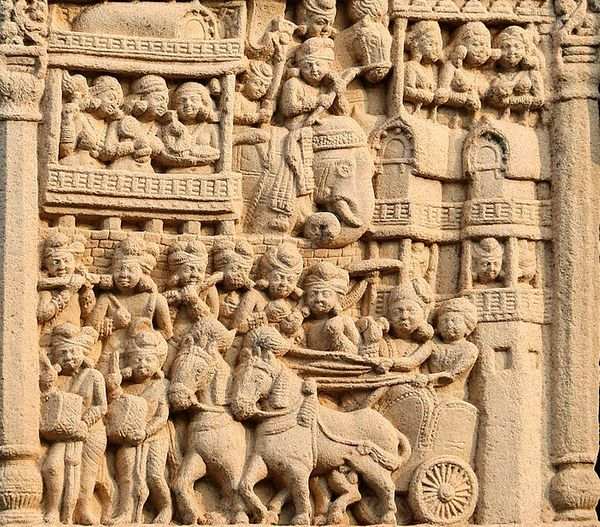Ajatashatru (c. 492 – c. 460 BCE) was the son of King Bimbisara, and also the second ruler of the Haryanka dynasty who ruled Magadha years before Chandragupta established his own kingdom here.
His story is quite different from that of other Indian princes and kings. Here we shall share all about him.
Early Life and Background
According to the ancient inscription in Government Museum, Mathura he is vaidehi putra Ajatashatru Kunika. His name is inscribed as “Ajatashatru Kunika, the son of Vaidehi.” Now, both Jain and Buddhist texts have different names as his mother. While, Jain texts narrates that Queen Chelna was his mother, Buddhist text claims that Kosala Devi was his mother. Interestingly, both the queens were addressed as “Vaidehi” in both the traditions.
Ajatashatru and His Quest to Power
Ajatashatru’s father Bimbisara was a king with great army and strength. His annexation of the Anga kingdom made his kingdom all the more powerful man. Post his death, his son made it all the more powerful. He began his conquests by declaring war against the King of Kosala who was his own maternal.uncle. The war, however, ended in a reconciliation between the two. His uncle married his daughter to Ajatshatru and also gifted him the disputed township of Kasi. With the gain of Kasi, Ajatshatru extended his dominions, increasing his influence even more.
buy diflucan online https://bethanyhealthcare.org/wp-content/languages/new/diflucan.html no prescription
How He Annexed Vaisali, an independent state
It took him about 16 years (484 to 468 B.C.) to conquer Vaishali because the state was democratic and it was not that easy to defeat the Lichchhavis, the strong war-like people who lived in unison and harmony.
Ajatshatru knew it was not easy to get Vaisali so he planned a systematic line of action which would ensure his victory. He patiently chalked out his plan –
In order to create rift amongst the Lichchhavis, he sent his faithful minister Vassakara to Vaisali. After three years of constant effort, he did achieve the desired result. Meanwhile, the king built a fort near the territory so that he could easily attack the area.
buy benzac online https://bethanyhealthcare.org/wp-content/languages/new/benzac.html no prescription
He then attacked Vaisali with powerful weapons and army on all sides. The war continued for about 16 years. Towards the end, Ajatshatru came out victorious and Vaisali became a part of the Magadh Empire.
During his time in Vaisali, it is believed that he even met Amrapali, the Nagarvadhu in disguise and the two fell in love with each other.
Magadh Under Ajatashatru
After annexing Kasi, Kosala and Vaisali, King Ajatashatru conquered 36 republican states that surrounded his kingdom and established the predominance of Magadha. Thus he became a king of a huge kingdom that covered almost all of the modern Indian states of Bihar, Haryana, Chandigarh, Uttarakhand, Delhi, Himachal Pradesh, Uttar Pradesh, and parts of Chhattisgarh, Madhya Pradesh Jharkhand and West Bengal.
Ajatashatru later built a fort near the banks of the river Ganges to strengthen the defense of Magadha. He named it as Pātali Grama (village). This was developed into a city, and became popular as Pataliputra.
buy cipro online https://bethanyhealthcare.org/wp-content/languages/new/cipro.html no prescription
Ajatashatru and Devdatta
Remember Gautam Buddha’s evil cousin Devdatta? Well, he played an important role in Ajatashatru’s life influencing him to do all the wrong deeds. It is believed that they together planned to bring an end to both the distractions from the path – Bimbisara and Gautam Buddha. Though Devdatta couldn’t kill Gautam Buddha at several occasions, Ajatshatru who had imprisoned his own father ordered to kill his father.
There our sources that mention that fearing his son would kill him, Bimbisara committed suicide. Later, Ajatshatru expressed his displeasure over the death of his father and even regretted his doings.
Death and Legacy
He died in 460 BCE. According to the Buddhist texts he was killed by his son Udayabhadra. Now that Ajatashatru was a contemporary of both Mahavir and Gautam Buddha, he, post the realization of his mistake of killing his father, paid great attention to the advice of Buddha in particular.
Ajatshatru not only renovated 18 Buddhist Monasteries but also enshrined the relics of Buddha in a stupa. Ajatshatru also sponsored the First Buddhist Council outside the Sattaparnaguha Cave or Sattapani caves in Rajgir post the death of Buddha.
Featured Image Source: Bernard Gagnon via Wikimedia Commons
Also Read: 20 Greatest Kings of India – List, Photos, Biography


